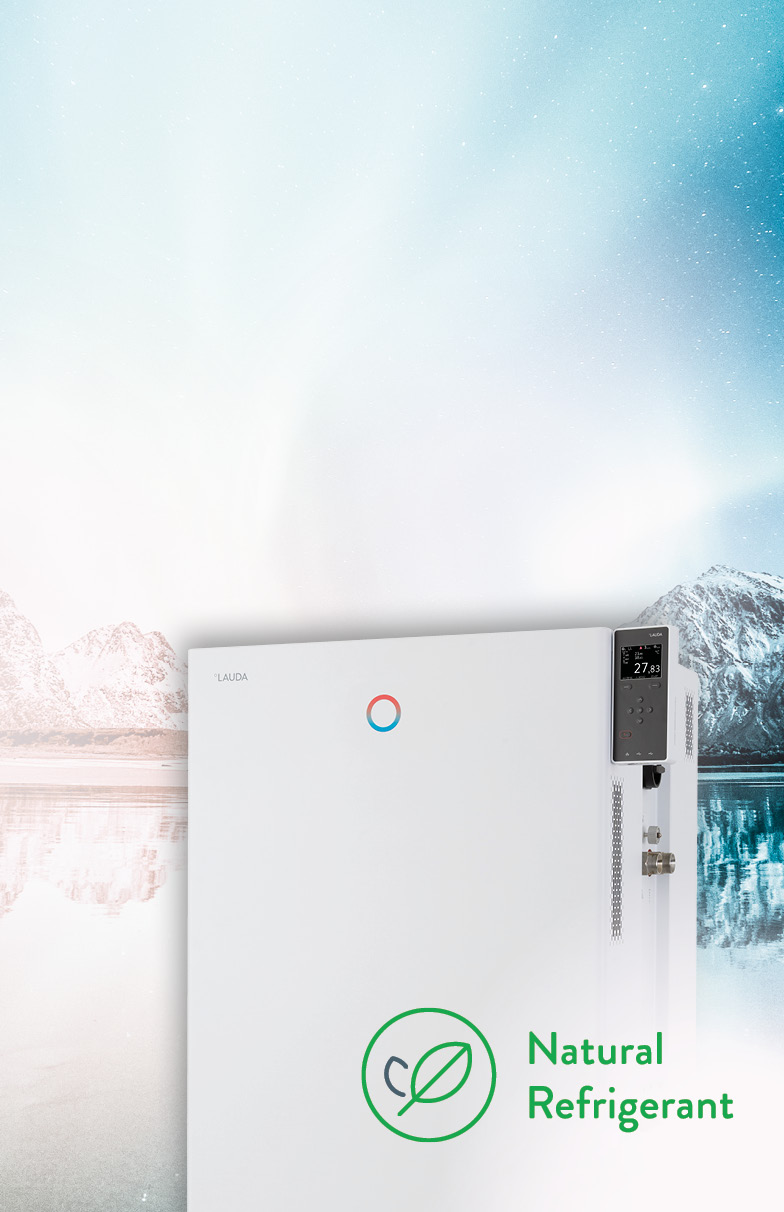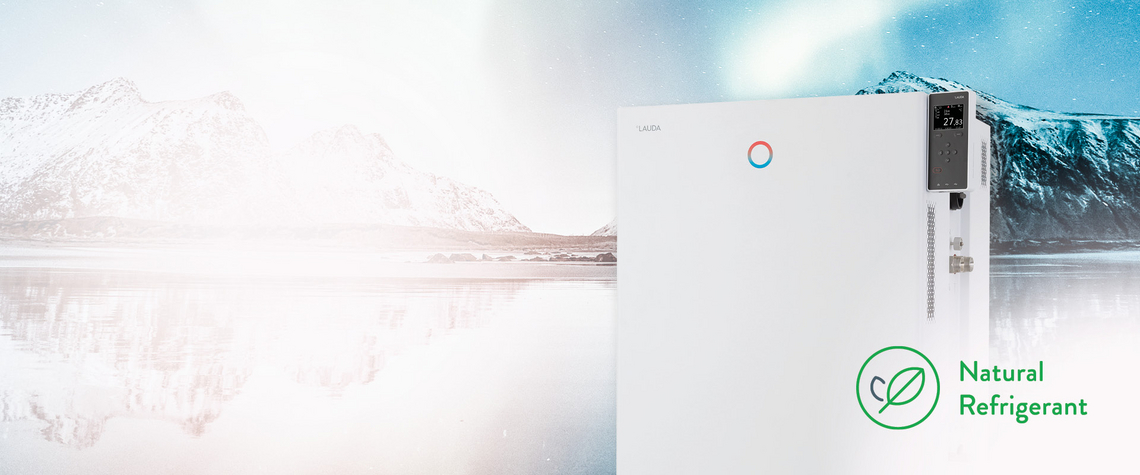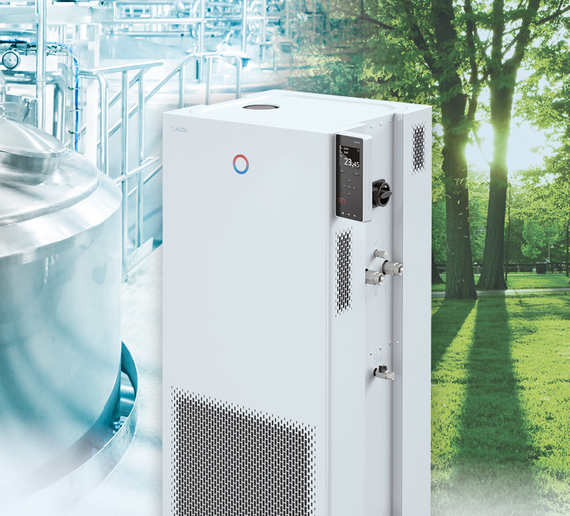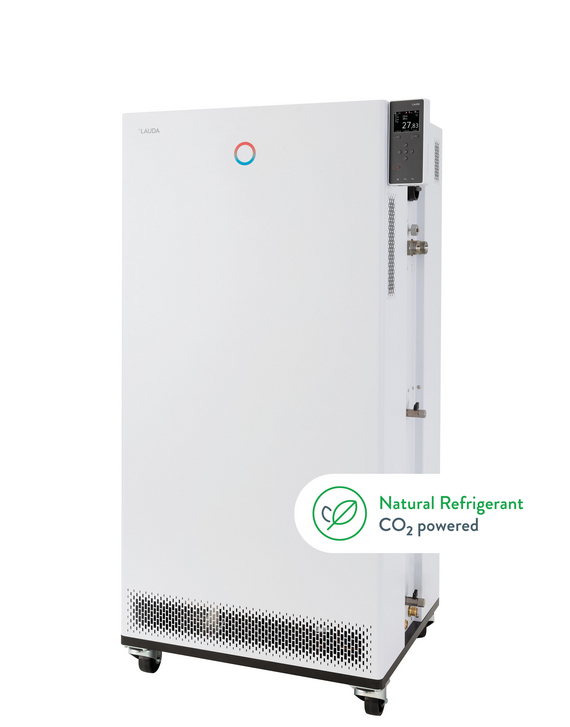




From compact laboratory thermostats to custom heating and cooling systems for plant engineering, LAUDA is a leading global supplier of precise, sustainable temperature control technology.
Our products are engineered for high energy efficiency and a low CO₂ footprint. This is especially critical since nearly 95% of a product’s lifetime CO₂ emissions occur during the operating life of the equipment.
Wherever possible, we integrate advanced electronic controls and speed-controlled compressor technology as standard features in our refrigeration systems, ensuring optimal performance and significant energy savings. Our high-performance product lines, such as LAUDA Ultracool, deliver up to 50% energy savings compared to conventional technology. We maintain these high standards in production across our entire product range ‒ from laboratory devices to industrial process thermostats.
A cornerstone of our long-established sustainability strategy is the transition to natural refrigerants in our refrigeration technology. For every application and product, we choose the refrigerant that delivers the optimal balance of performance and environmental benefits. This approach continuously reduces our products’ carbon footprint, fully aligning with current regulatory requirements and LAUDA’s sustainability goals.
The European Union’s F-Gas Regulation and other international requirements (such as those of the US EPA) mandate a gradual phase-down of fluorinated refrigerants with high GWP values. These regulations create a strong incentive to develop and implement innovative technologies that use natural refrigerants. By offering a comprehensive range of refrigeration solutions, LAUDA already makes it possible to switch to future-proof, sustainable refrigerants that can be tailored to your individual application needs.

What is CO₂ (R744)?
R744 is the official designation for carbon dioxide (CO₂) when used as a refrigerant. This naturally occurring substance does not harm the ozone layer and has a very low global warming potential (GWP of 1) compared to synthetic refrigerants like HFCs and F-gases. Although classified as non-flammable (A1), R744 requires specialized components and enhanced safety measures due to its high operating pressures. Today, it is widely used for central cooling in supermarkets, commercial refrigeration, specialized industrial systems, and heat pumps.

What is Propane (R290) / ...?
R290 is the official designation for propane when used as a refrigerant. For LAUDA and for the refrigeration and air conditioning industry, R290 is extremely important due to its eco-friendly properties, versatility, and high performance. Like R744, R290 is a naturally occurring refrigerant, with no ozone depletion potential (ODP) and a very low global warming potential (GWP of 3). It is ideal for use in household appliances such as refrigerators, air conditioners, and dryers, as well as in industrial systems ‒ especially in chemical and pharmaceutical applications ‒ thanks to its robustness. Moreover, integrated safety features make R290 easy to install and operate, even in systems requiring larger refrigerant charges. These advantages are also reflected in other A3 refrigerants, such as R170 (ethane) and R1270 (propene).
Please contact us for individual advice.
| Device with natural refrigerant R744 = CO₂ | Device using natural refrigerants / hydrocarbons (e.g. R290 = propane) | Device with HFO refrigerants / synthetic F-gases (e.g. R455A) | Reference: HFC refrigerants / classic F-gases (e.g. R134a) | |
|---|---|---|---|---|
| Safety class | A1 | A3 | A2L | A1 |
| Toxicity | No | No | No | No |
| Flammability | No | Yes | Low | No |
| Danger of asphyxia | Yes | Low | Low | Low |
| Specific safety requirements | For installation in cellars or above ground without emergency exits: Minimum room volumes of the installation site and ventilation if necessary (risk of suffocation in the event of leakage). | None up to 150 g refrigerant load. From 150 g refrigerant load: Minimum volumes of the installation location, leakage sensor and ventilation if necessary. | None up to 150 g refrigerant load. From 150 g refrigerant load: Minimum volumes of the installation location, leakage sensor and ventilation if necessary. | None |
| GWP (Global Warming Potential = CO₂ equivalent) | 1 | < 10 | < 1 to < 700 | Normally > 1000 |
| COP (Coefficient Of Performance = Ratio of cooling capacity to the electrical power used at full load and tb=20 °C) | approx. 3 (single-stage compressor, long-term stability at lower temperatures) | approx. 3,6 (decreases steadily at lower temperatures) | approx. 3,3 (decreases steadily at lower temperatures) | approx. 3,3 (decreases steadily at lower temperatures) |
| Temperature range | Down to −45 °C (single-stage) | Down to −100 °C | Down to −50 °C | Down to −100 °C |
| Heat discharge | Water-cooled only | Air and water cooling possible | Air and water cooling possible | Air and water cooling possible |
| Conclusion | Limited minimum temperature. High energy efficiency and cooling capacity under ideal working conditions (water-cooled, indoor installation). Additional costs due to higher system pressures. Low safety requirements. | Technically ideal replacement for classic F-gases with high energy efficiency. Air and water-cooled design, all temperature ranges can be realized. Established safety technology. | Slightly reduced, but similar safety requirements to natural A3 refrigerants, lower cooling capacity density requires larger systems for comparable cooling capacity. | State-of-the-art technology, high energy efficiency and low safety requirements. |
The natural refrigerant R744 (CO₂) excels in applications that require high cooling capacity, indoor installation, outlet temperatures below 0 °C, and a central cooling water supply ‒ offering both energy efficiency and ease of installation.
The natural refrigerant R290 (and other A3 refrigerants), which can serve as a nearly one-to-one replacement for fluorinated refrigerants, is well suited for both indoor and outdoor installations, whether air- or water-cooled. Its high energy efficiency at temperatures above 0 °C, along with integrated safety features for handling larger refrigerant charges, makes R290 a more cost-effective solution in many cases.
LAUDA offers an extensive portfolio of refrigeration solutions, customized to meet a variety of application needs and installation environments.
Please contact us for individual advice.

The LAUDA Integral XT process thermostats operate on a flow principle with a cold-oil overlay, which extends the effective temperature range of the control fluids ‒ ideal for dynamic temperature control applications. The electronically controlled, magnetically coupled pump adjusts the flow rate to precisely meet the needs of both pressure-sensitive systems and applications with high hydraulic resistance.
Key Features of the IN 2040 XTW:
| Transport by | Freon / F-Gas | Natural refrigerant – A1 (CO₂) | Natural refrigerant – A3 (Propane, Ethane, etc.) | HFO – A2L refrigerant |
|---|---|---|---|---|
|
Road | Yes * | Yes * | Yes, up to 12 kg refrigerant load | Yes * |
|
Air | Yes * | Yes * | Yes, up to 100 g refrigerant load ** | Yes, up to 100 g refrigerant load ** |
|
Sea | Yes * | Yes * | Yes * | Yes * |
* Additional delivery documentation required for systems with > 12 kg refrigerant load.
** LAUDA offers special logistics and service processes for urgent transportation of appliances with > 100 g refrigerant (class A3 and A2L) via air freight.
Local regulation may impose stricter limits or add additional parameters. Please verify your legal obligations.
Any violations on logistic regulations are within the shippers sole responsibility if transport is not undertaken by LAUDA.
There are already three products on your comparison list.
To compare other products, please delete one of the products on your comparison list.